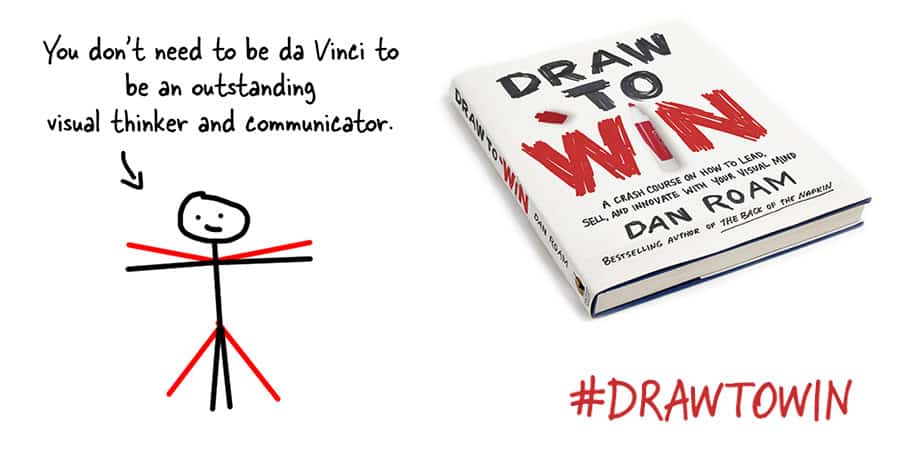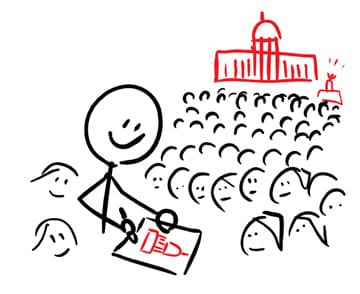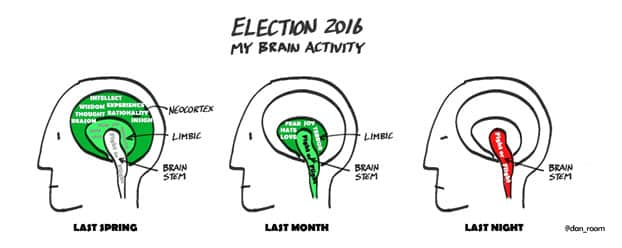Revealed: Leader, Draw Your Vision

In my new book “Draw to Win,” I draw leadership lessons from John F Kennedy’s “We go to the moon” and Martin Luther King Jr’s “I have a dream” speeches. I share them as unforgettable examples of the power of spoken images. These speeches remind us that when you lead, you must draw a mental picture that galvanizes your troops, inspires your teams, and vividly guides to all people who come in contact with your business.
Over the past months, and culminating in the surprising outcome of the recent Presidential election, we’ve witnessed the power of verbal pictures more viscerally than at any point in political history. We can now add “Build a wall,” “Drain the swamp,” and “Take back our jobs,” into the portfolio of persuasive presidential visions.
Whether you like the election outcome or not, the lesson is undeniable: the conversation today is short, simple, and above all, visual. If you want to be in the conversation, you need to be visual, too.
“I prefer drawing to talking. Drawing is faster, and leaves less room for lies.” – Le Corbusier
A vision is a picture
A recent study in the Harvard Business Review revealed that U.S. presidents who used image-based words in their speeches were considered to be more charismatic than those who didn’t. “These findings suggest that the successful articulation and enactment of a leader’s vision may rest on his or her ability to paint followers a verbal picture of what can be accomplished with their help.”
As a leader, you’ve been told a thousand times you need a vision statement. Forget it; you don’t need a vision statement – what you need is the ability to see your destination and then draw the simplest possible path from here to there.
I’m not asking you to actually draw anything; not yet. For now, it’s enough to look for words that could be drawn. As you look for the right picture and the best image words to describe it, four lessons from this election become stunningly clear.
1. Simple beats complex
Let’s say I want to sell you a food product. I could tell you all about Theobromine, an alkaloid chemical with the formula C7H8N4O2. I could tell you it is a bitter-tasting crystalline powder that when dissolved in water and ingested has a similar effect on the human nervous system as caffeine. I could explain that Theobromine is naturally white or colorless, but when heated and mixed with other digestable compounds becomes brown in color. I could even tell you that despite its name, the compound contains no bromine—theobromine is derived from Theobroma, meaning “food of the gods.” I could tell you all these things.
Or I could say, “Chocolate.”
Which one do you buy?
2. Black and white beats shades of gray
The world is complex and business is complicated. You know this, and so does everyone you lead. But if you’re my leader, you take your chances when you to tell me that the path to our destination is long, winding, uncertain, and fraught with difficulties. I’ve got enough problems of my own to deal with, and unless I truly believe you care deeply for me personally, your cold reality isn’t an easy sell. Compromise, negotiation, and contemplation demand more energy than I can spare, so spare me the nuances. Give me the bottom line up-front. Then I can decide if I agree and move on to whatever comes next.
This isn’t new; behavioral economists have for years been lamenting choice fatigue. According to the “paradox of choice” argument put forth by psychologist Barry Schwartz, the more choices you have, the less likely you are to select anything. Leader, you’d be well advised to remember this: if you want input-saturated people to take action, make the decision a yes-or-no.
3. The specific beats the general
When you look directly at me and say, “I can solve your client project problem this week,” I’m going to feel pretty good. I might not believe you, but you’ve got my attention and, until you prove yourself wrong, I’ll gladly support you. Why wouldn’t I? As far as I’m concerned, it’s only upside; if you’re right, my problem is solved. If not, I’m no worse off than I was before, right?
But if you say, “These kinds of multi-layered problems are notoriously challenging, so we should initiate and test a new series of business policies to see if we can better navigate them in the future,” I’m going to think, “Sounds like the same old BS to me.”
If you want me to support you right now, you’d better listen really well to what my most specific problem is, and tell me you’ve got a specific solution. Whether you can actually execute is a different question – but hopefully your short-term win should buy you enough time to figure that part out. If you can’t, I’ll pick the next specific answer that comes along.
4. Emotions beat everything
The human brain works on many levels. At bottom, your brain-stem responds to simple sensory inputs with immediate “fight or flight” reactions. Next up the chain, your limbic brain triggers emotional responses to what you perceive: happiness, sadness, fear, lust, hatred, and joy. At the top, your massive neocortex enables you to pause, take a breath, analyze your reactions and emotions, think them through, and then make informed decisions based on evidence, experience, reason, and insight.
Here’s an interesting data point: although your brain is a relatively small organ, accounting for only two percent of your total body weight, it is an energy hog, consuming twenty percent of the calories you burn each day. But get this: emotional reactions are the low-energy path to decision making. When a tired person faces a complex problem, the easiest decision is to fall back on how it feels. Hate, fear, love, and joy trump deeper thought. From an energy-management perspective, it’s more efficient to let your limbic brain make the call.
At the beginning of this Presidential race, we all expected to use our neocortexes to help us make such a momentous decision. But during the early debates, it became clear that we were probably going to work primarily at the limbic level. By the end, it was all brain stem. The lesson: when the factual truth is complicated, ring the amygdala. It works every time.
Leader, you are on a quest
As a leader, you are on a quest. You are leading your team to a destination, and in the short-term, more than anything else, you will be judged on how clearly you see it and how simply you describe the path to reach it. The lesson for leaders is clear: keep it simple, keep it clear, keep it visual.
Have you read?
Managing Conflict Between Generations
Three things only the c-suite can do to lead a high-performance culture
What You Don’t Know Can Hurt You: Trading in Non-Transparent FX Markets
Ten Countries Where Both Facebook And Twitter Are Losing Active Users
Written by Dan Roam, author of “Draw To Win.”
Bring the best of the CEOWORLD magazine's global journalism to audiences in the United States and around the world. - Add CEOWORLD magazine to your Google News feed.
Follow CEOWORLD magazine headlines on: Google News, LinkedIn, Twitter, and Facebook.
Copyright 2025 The CEOWORLD magazine. All rights reserved. This material (and any extract from it) must not be copied, redistributed or placed on any website, without CEOWORLD magazine' prior written consent. For media queries, please contact: info@ceoworld.biz















